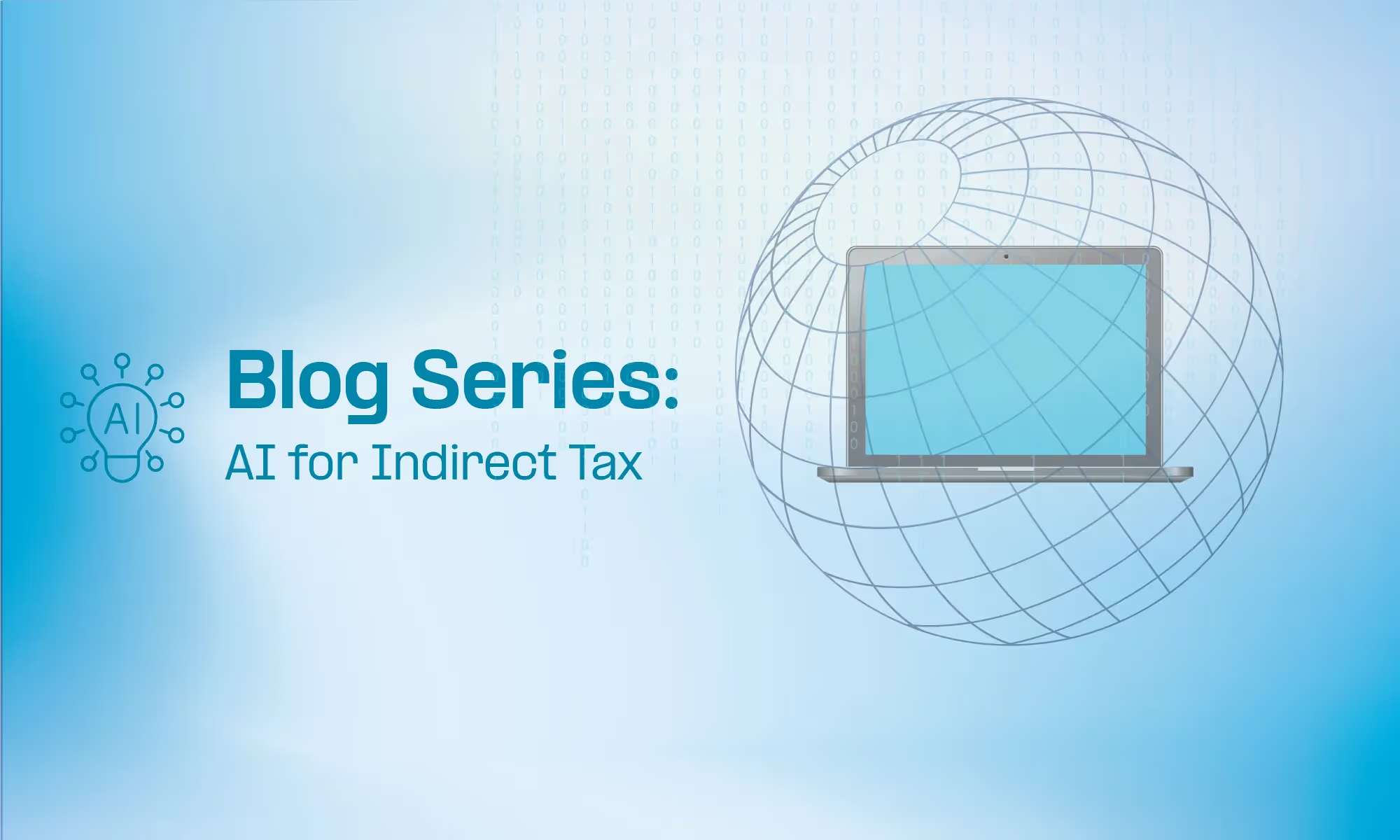The AI vendor pitch always sounds the same: "Our solution will transform your entire tax function." They show you dashboards, accuracy scores, and case studies. Everything looks promising until you ask the question that actually matters: "Which specific processes should we trust this for?"
The silence that follows tells you everything.
Not every tax process is equally suited to AI. The technology that works brilliantly for scanning millions of invoices for anomalies could be catastrophic if you let it calculate tax rates on live transactions. The challenge isn't whether to adopt AI. It's knowing exactly where it adds value and where it introduces unacceptable risk.
This is the third piece in our series on preparing indirect tax leaders for AI. In the first article, we explored why tax systems can't be both perfectly certain and infinitely adaptable. In the second, we examined why AI's occasional errors might actually improve your overall compliance posture. Now we tackle the strategic question: how do you map your tax operations to determine where AI belongs?
The answer requires a spectrum, not a binary choice.
Some processes demand 100% accuracy with zero tolerance for error
Large enterprises need to map out where deterministic precision is critical versus where AI's strengths can be safely leveraged. We can classify indirect tax use cases on a spectrum from "determinism-critical" to "AI-advantaged."
Determinism-critical use cases are processes where even a small error has significant consequence, and the logic is relatively well-defined.
Transaction-level tax determination (calculating the correct VAT or GST on each invoice or sale) is a prime example. Here, the requirements are black-and-white: either the rate is right or it isn't, according to law. A customer purchase either is taxable or exempt under specific conditions. There's little room for guesswork.
For such decisions, companies currently rely on tax engines (SAP Tax, Vertex, Avalara) which apply explicit tax rules and rates maintained by experts. The tolerance for AI getting a tax rate "probably right" is low. 100% accuracy is expected for each transaction, because even a 1% error on millions of invoices can mean compliance breaches and unhappy customers.
Another determinism-critical area is statutory tax filings formatting. Generating an electronic VAT return in the required government schema needs to match exactly what authorities prescribe. There's no "almost correct" JSON schema. It either passes or fails validation.
Similarly, any hard regulatory deadline or binary compliance step (like on-time filing, or charging at least the minimum legal rate) should be anchored by deterministic controls.
In short, "bright-line" requirements (areas governed by clear rules and with high penalty for deviation) should remain under deterministic or rule-based logic. AI can still assist (perhaps by pre-checking the logic or suggesting updates) but the final call should be rules-based.
As a rule of thumb, if a missed flag or a false prediction in that area could jeopardize a merger or incur a major fine, stick to deterministic logic as the backbone.
The middle ground: layer AI assistance with deterministic final checks
Many tasks combine elements of routine rules and open-ended analysis.
Tax research and advisory is one. Determining tax treatment for a novel business scenario might start with deterministic checks ("Is there a rule or court ruling on this exact scenario?") but then require probabilistic reasoning ("This situation is 70% similar to a case where tax was due, let's assess the likelihood...").
Tax controversy and audit support is another. Responding to tax authority queries often involves reviewing large document sets for relevant info (AI can summarize and search these), but also careful legal judgment (a human must decide how to respond).
Regulatory monitoring is well-suited to AI up to a point. AI agents can scour hundreds of sources for tax law changes across the globe and even translate and summarize them. In fact, generative AI has shown it can "read, translate and accurately summarize a complex tax document in seconds," which is enormously valuable. However, determining if a law change applies to your business or exactly how it alters your obligations might require a human's deterministic application of that summarized insight.
In these use cases, the strategy is "layered AI": use AI to expand coverage and handle grunt work, then apply deterministic checks or human judgment for final decisions.
For example, indirect tax audit preparation can use AI to compile all transaction data and flag anomalies (pattern recognition), but a tax manager then systematically verifies the flagged items against known rules before an audit. Tax accounting and provisioning is another middle area. AI can comb through ledgers to identify outliers or estimate exposures, but the final booked provision might need to follow strict accounting rules.
AI excels where complete coverage matters more than perfect precision
These are areas where the problem is intractable or too resource-intensive for rule-based or manual methods, and a bit of uncertainty is acceptable compared to the status quo. Often these tasks are not done at all today, or done partially.
Anomaly detection in large datasets is a prime example. Scanning 10 million invoices for odd patterns (potential double taxation or omitted tax) is something only AI can do effectively. A human team might check a small sample or react only when an issue is obvious, whereas an AI can systematically review all transactions and surface the top 0.1% for closer review.
Even if some flagged anomalies are not real issues, the fact that AI can trawl billions of data points means it provides a safety net over the entire population. In one case study, an AI solution processed 5 to 6 million incoming invoices a year (about 300 times what a human could) and dramatically increased the chances of catching errors.
When the choice is between probabilistic insight or no insight at all, the probabilistic approach clearly wins.
Fraud detection in indirect tax (carousel fraud in VAT, or detecting bogus vendors in accounts payable) also falls here. These schemes often involve complex networks and patterns that no simple rule can capture. AI models are known to be effective at flagging unusual relationships or behaviors, which humans can then investigate.
Document processing and classification is another AI-advantaged area. Extracting data from invoices, receipts, or tax forms at scale via AI (using OCR and machine learning) can save enormous time, with acceptable error rates that humans then clean up. For example, automating accounts payable tax coding with AI might achieve 90% accuracy. The remaining 10% are handled by staff. This is far superior to having staff do 100% manually at much slower speeds.
Generative AI for drafting responses or routine communications can also be valuable. Drafting a first version of a tax technical memo or preparing a summary of a new law. If the stakes aren't life-or-death, an AI draft that a human polishes can be a huge productivity gain.
Visualize your tax processes on a heat map of AI suitability
To visualize this spectrum, imagine a heat map of tax processes versus AI suitability.
On one extreme (red, low AI tolerance) we have things like "real-time tax calculation on e-commerce checkout." Here you must be right every time in milliseconds. Likely stick to rules.
On the other extreme (green, high AI leverage) we have "quarterly risk analytics on tax data." Here AI can crunch data and give probabilistic risk scores that management uses for decision-making. A bit of error is tolerable because it's about focusing attention effectively, not making a binding decision per se.
Many processes fall in between and can adopt a hybrid approach. For instance, "contract review for tax clauses" could use deterministic text search to find key legal clauses (must not miss known required clauses) combined with AI NLP to flag unusual provisions that "look" risky compared to a corpus of contracts.
In practice, enterprises are combining approaches: "Use deterministic rules to enforce bright-line requirements, then add probabilistic scoring for discretionary calls," as one legaltech expert suggested. This layered strategy ensures that compliance fundamentals are not compromised, while AI is still mining the gray areas for value.
Key takeaway: Deploy AI strategically, not universally
Large enterprises should map their indirect tax operations and triage use cases. Keep core compliance decisioning anchored on reliable rules. Inject AI where it can surveil large data, provide decision support, or handle unstructured inputs. And always have a fallback plan (either human review or a default rule) for when AI's confidence is low.
This mapping exercise prevents over-reliance on AI where it's not appropriate, and conversely prevents missing out on AI's benefits where it clearly outperforms traditional methods.
The strategic question isn't "Should we use AI?" It's "Where exactly does AI make us better, and where does it make us vulnerable?" Answer that honestly, and you'll build a tax function that's both more capable and more resilient.



















